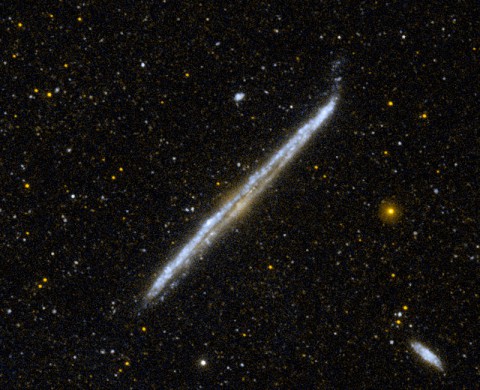Global Thermostat's pilot plant in Menlo Park, Calif., pulls carbon dioxide from the surrounding air. The next challenge is to find uses for the captured gas.
Courtesy of Global Thermostat Global Thermostat's pilot plant in Menlo Park, Calif., pulls carbon dioxide from the surrounding air. The next challenge is to find uses for the captured gas.
Courtesy of Global Thermostat Every year, people add 30 billion tons of carbon dioxide to the air, mostly by burning fossil fuels. That's contributing to climate change. A few scientists have been dreaming about ways to pull some of that CO2 out of the air, but face stiff skepticism and major hurdles. This is the story of one scientist who's pressing ahead.
Peter Eisenberger is a distinguished professor of earth and environmental sciences at Columbia University. Earlier in his career, he ran the university's famed Lamont-Doherty Earth Observatory and founded Columbia's Earth Institute. He was never one of those scientists who tinkered into the night on inventions. But he realized he didn't need to be.
"If you looked at knowledge as a commodity, we had generated this enormous amount of knowledge and we hadn't even begun to think of the many ways we could apply it," Eisenberger says. He decided he'd settle on a problem he wanted to solve and then dive into the pool of knowledge for existing technologies that could help him.
He started looking for a way to pull carbon dioxide right out of the air. "And it turned out the best device already exists," he says. "It's called a monolith. That is the same type of instrument that's in the catalytic converter in your car. It cleans up your exhaust."
Eisenberger's monoliths grab carbon dioxide from the air and release it again when you heat them up.
He teamed up with a colleague at Columbia, Graciela Chichilnisky, and formed a company to develop the idea. Global Thermostat got seed money from Edgar Bronfman, Jr. ? CEO of Warner Music Group and the former CEO of Seagram's, his family's business.
The company has built two pilot plants at SRI International in Menlo Park, Calif. But of course there are big issues to solve: What do you do with the carbon dioxide once you've captured it, and how do you make money?
"If they don't tell you you're crazy, you're not doing something worthwhile," says Peter Eisenberger, co-founder of Global Thermostat, a firm that's building a device to pull carbon dioxide from the air.
Chris Schmauch/Global Thermostat "So we then we looked for ways to monetize CO2 and found that lots of people wanted to use CO2 as a feedstock to make a valuable product," Eisenberger says.
Growers pipe carbon dioxide into greenhouses. Oil companies pump it underground to help them squeeze out more oil. Soda companies use it to put bubbles in their drinks. These are mostly small-scale applications.
Maybe someday Eisenberger could get paid to clean up the atmosphere by sucking out the CO2 and burying it underground, though there's no market for that now.
But using carbon dioxide to make fuel could someday be big. So Eisenberger's first project involves using CO2 to feed algae that churn out biofuel.
"Our first demonstration plant is being erected right now down in Daphne, Alabama, with an algae company called Algae Systems, which sits on Mobile Bay," Eisenberger says. "They'll be floating their algae in plastic bags on the top of the water. We'll be piping in CO2 that we pull out of the air, and the sun will do the rest."
Of course, this one project will have zero effect on how much carbon dioxide is in the earth's atmosphere. But Eisenberger has much grander ambitions.
"I believe we have something that's economically viable, so our company will be successful," he says. "But I'm really in this because I want to contribute to a long term solution that the world needs."
Eisenberger says if he can open the door to capturing carbon dioxide from the air ? and make the process cheap enough ? someday we could actually slow down, or possibly even reverse, the buildup of carbon dioxide in the atmosphere.
Robert Socolow at Princeton University started hearing a buzz about this technology a few years back.
"It's catchy," Socolow admits. "It's attractive conceptually that one could basically pour carbon dioxide into the atmosphere for the next several decades and pull it out later and everything would be fine." But the appeal of the idea also worried him ? people might use the mere prospect of this technology as an excuse not to act.
So Socolow spearheaded a critique of the technique, on behalf of the American Physical Society.
Socolow's panel concluded that the technology would be hopelessly expensive, costing $600 for every ton of carbon dioxide it drew out of the air. And the scale would also be huge. In order to capture the emissions would waft into the air from a single coal-fired power plant, you'd need to build a structure 20 miles long and 30 feet high. "It's like the Great Wall of China," Socolow says.
The committee concluded that it would make a lot more sense to cut down on emissions first ? make our cars, homes and factories more efficient. Panel members also said it makes much more sense to capture carbon dioxide directly from smokestacks, where it's concentrated, instead of from the air.
Socolow says, maybe someday we'll have our emissions under control, and then we might need to remove some of the carbon dioxide that's already in the air with a capture technology. But, in his view, that's a long way away. "I locate it in the 22nd century," he says. In other words, this might be a good project for Eisenberger's great-great-great grandchildren.
Researchers currently working on carbon dioxide capture technologies say the American Physical Society critique has made it much harder for them to raise money. Klaus Lackner at Columbia University says he was turned down for a government grant. David Keith at Harvard and the University of Calgary says he struggled to get funding for his small company.
"It's a very powerful report from a very credible group of people, and it may well help to kill us and other efforts," Keith says.
Proponents of air-capture technologies say some of the panel's conclusions are just plain wrong ? especially the estimated cost of $600 per ton.
"We have had third party reports, independent people, evaluating our technology, and it's under $50 a ton," Eisenberger says. He hasn't actually demonstrated that cost yet, and he agrees that nobody should take his word for it. But he's stopped arguing with his critics.
"I'm just going to go do it," he says. "And doing it or not ? that's the answer."
Pursuing a big idea takes some hard-headedness and thick skin.
"If they don't tell you you're crazy, you're not doing something worthwhile," Eisenberger says. "Because what you do when you innovate is you disturb the existing order."
Fortunately, this won't be an academic argument forever. "That's the beauty of science. The people that take the time to come into the lab and see it working and do their own evaluation of the cost and the performance, they know it's not crazy."
If the researchers pursuing this technology can really make it inexpensive to draw carbon dioxide out of the atmosphere, Eisenberger says it could be a game-changer.
We could start producing fuels with the carbon dioxide that's already in the air, instead of unearthing more fossil fuels. This won't happen quickly, though.
"The energy infrastructure of the world is $55 trillion," Eisenberger says. So a technology to replace that is "not like a new Google app."
Still, human societies have made such transitions before. "They just don't happen in a day," Eisenberger says. "But they happen."
There's certainly no guarantee that capturing carbon dioxide from the air would ever become a big enough enterprise to make a difference to Earth's climate. But it won't even be put to the test unless people like Eisenberger give it a try.
Source: http://www.npr.org/2013/06/27/189522647/this-climate-fix-might-be-decades-ahead-of-its-time?ft=1&f=1007
kellie pickler miranda kerr brian urlacher NBA Mock Draft 2013 Xbox reveal Skagit River Bridge Call Of Duty Ghosts

 Pasadena, CA ? NASA has decommissioned its Galaxy Evolution Explorer after a decade of operations in which the venerable space telescope used its ultraviolet vision to study hundreds of millions of galaxies across 10 billion years of cosmic time.
Pasadena, CA ? NASA has decommissioned its Galaxy Evolution Explorer after a decade of operations in which the venerable space telescope used its ultraviolet vision to study hundreds of millions of galaxies across 10 billion years of cosmic time.
 In a first-of-a-kind move for NASA, the agency in May 2012 loaned GALEX to the California Institute of Technology in Pasadena, which used private funds to continue operating the satellite while NASA retained ownership. Since then, investigators from around the world have used GALEX to study everything from stars in our own Milky Way galaxy to hundreds of thousands of galaxies 5 billion light-years away.
In a first-of-a-kind move for NASA, the agency in May 2012 loaned GALEX to the California Institute of Technology in Pasadena, which used private funds to continue operating the satellite while NASA retained ownership. Since then, investigators from around the world have used GALEX to study everything from stars in our own Milky Way galaxy to hundreds of thousands of galaxies 5 billion light-years away. ?In the last few years, GALEX studied objects we never thought we?d be able to observe, from the Magellanic Clouds to bright nebulae and supernova remnants in the galactic plane,? said David Schiminovich of Columbia University, New York, NY, a longtime GALEX team member who led science operations over the past year. ?Some of its most beautiful and scientifically compelling images are part of this last observation cycle.?
?In the last few years, GALEX studied objects we never thought we?d be able to observe, from the Magellanic Clouds to bright nebulae and supernova remnants in the galactic plane,? said David Schiminovich of Columbia University, New York, NY, a longtime GALEX team member who led science operations over the past year. ?Some of its most beautiful and scientifically compelling images are part of this last observation cycle.? This week, while the media has been schooling us on the student loan implosion and interest rates possibly doubling unless Congress takes action, Roger W. Ferguson Jr. and Debra W. Stewart ?published an opinion piece at Politico addressing an issue at the core of BetterInvesting?s curriculum ? financial education.
This week, while the media has been schooling us on the student loan implosion and interest rates possibly doubling unless Congress takes action, Roger W. Ferguson Jr. and Debra W. Stewart ?published an opinion piece at Politico addressing an issue at the core of BetterInvesting?s curriculum ? financial education.


